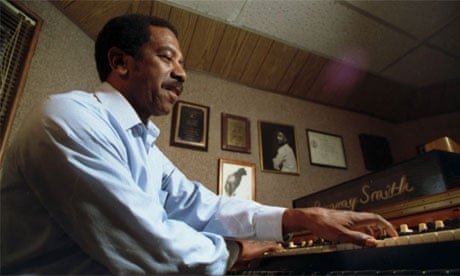The Hammond organ wasn't originally designed for jazz clubs, but for churches that couldn't afford a full-blown pipe organ. Unveiled in 1934 by Laurens Hammond (a gifted engineer who had designed an automatic gearbox for cars while still in his teens), the machine depended on an electric motor rotating tonewheels at different speeds, and with different patterns of bumps along their edges. As they spun, the wheels produced sounds of varying pitches, captured by electromagnetic pickups and sent to a speaker. Not only could the Hammond mimic the effects of a pipe organ, but made many other sound effects too, which led to its extensive use in radio studios during the 1930s and 40s.
George Gershwin immediately bought one when he played the 1934 prototype, and the portability of the instrument made it popular with travelling preachers, and in American military chapels during the second world war. Jimmy Smith, the great Philadelphia-born jazz keyboardist, didn't pioneer the Hammond's use in jazz (Fats Waller, Count Basie, Milt Buckner and Wild Bill Davis were among those who'd already played it), but he is its most famous and charismatic exponent.
James Oscar Smith (born 8 December 1928, in Norristown, Pennsylvania, the son of a song-and-dance man) burst on to the jazz scene in the mid-1950s when he debuted at Smalls Paradise on New York's 7th Avenue. There, he caught the attention of Blue Note Records, and went on to play the high-profile Newport Jazz festival in 1957. Here's an early Smith classic (Charlie Parker's Au Privave) from the superb recordings he made for Blue Note in 1957-8, demonstrating both his blues power and his bebop virtuosity (in the esteemed company of trumpeter Lee Morgan, and saxophonists Lou Donaldson and Tina Brooks).
Smith won a Philadelphia radio talent contest as a boogie-woogie pianist when he was only nine, went on to perform with his father as a teenager, and played piano in Philly R&B bands in the early 1950s. But on hearing Chicago swing organist Wild Bill Davis, Smith became hooked on the electric organ. Davis was an innovator who had exploited the dramatic, gospel, vibrato-laden sound of the Hammond's rotating Leslie loudspeaker to the full. He also popularised the organ/guitar/drums lineup, creating a bass-line with the pedals. But Smith played keyboards in the more intricate and harmonically complex style of a bebop pianist (though he was rarely far from the chord-form of the blues), and took foot-pedalling to another level, developing a dazzling technique that mimicked the intricate "walking" lines of a bop double-bassist. With such virtuosity, Smith was able to invent himself as a one-man bop soloist and rhythm section combined.
Playing with star guitarists such as Kenny Burrell and Grant Green, Smith's popularity swelled in the 1960s and 70s. The gospel-choir roars he coaxed from the Hammond, the wild, blues-steeped trills and boneshaking bass notes became something of a formula, but it was one he constantly invoked with a manic energy. Moving from Blue Note to Verve Records, Smith made a series of big-budget commercial recordings including The Cat, Got My Mojo Workin', and the classical/jazz hybrid Peter and the Wolf. But 1962's Walk On the Wild Side (fronting an atmospheric Oliver Nelson big band) and The Sermon became jazz classics. Smith went out of fashion in the 1980s but came back in the 90s, riding a jazz revival that highlighted the bluesiest and most danceable qualities of the music. He recorded Dot Com Blues for Universal in 2000, with illustrious guests including BB King, Etta James, Keb' Mo', Taj Mahal, Phil Upchurch and Dr John. Smith died on 8 February 2005, aged 76.

Comments (…)
Sign in or create your Guardian account to join the discussion